Sunday evening saw the Parisian derby being held between Paris FC and Paris Saint-Germain. For the interest of this article, from now on, I will refer to Paris FC as Paris and Paris Saint-Germain as PSG.
Paris came into this game following a major midweek win against Spanish giants Real Madrid, vital points in what is being dubbed the group of death. However, in the league, they came into this game sitting in second place, six points ahead of PSG; PSG still have two games in hand.
Much like Paris, PSG came off an important midweek win against Roma in the Champions League. In the league, they have also been in good form, although dropped points in a 1-1 draw against mid-table Le Havre a week prior.
In this tactical analysis, we look at some key tactics that helped PSG gain an advantage over Paris in this vital top-of-the-table clash. This analysis will cover how the Paris press caused problems for PSG in the first half and how they overcame this in the second half.
Lineups
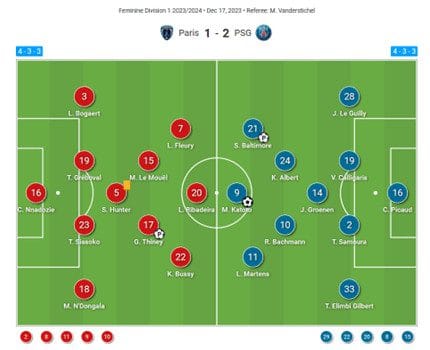
The home side, Paris, started with Chiamaka Nnadozie between the sticks, having started ten of the eleven league games so far this campaign, including all three Champions League fixtures. Then, at left-back, Paris played Lou Bogaert, who has been rotating game time with Alsu Abdullina; however, more recently, Soubeyrand has favoured Bogaert. Thea Greboval also held up position in the backline, although moved from right centre back midweek to the left side against PSG. Then came the first of multiple changes made from their midweek Champions League win, with Teinsoun Sissoko and Melween N’Dongola all coming into the side to complete the backline for Paris.
Paris changed things significantly in midfield, with Sarah Hunter making her first start of the season, having completed her summer transfer from Sydney FC. In addition to this change, they also gave a start to Margaux le Mouel. Both Daphne Corboz and Kaja Korosec dropped to the bench. However, le Mouel, Corbz and Korosec have been somewhat rotated throughout the season to date, so that wasn’t too much of a surprise. Then mainstay and Captain Gaetane Thiney completed the midfield three-off. They operated with Sarah at the base of the midfield, and Thiney and le Mouel played in more advanced positions, looking to support the attacks.
In attack, Paris again significantly rotated from midweek, with none of the starters from midweek starting against PSG. In this game, they opted for Louise Fleury on the left. Louna Ribaderia is through the middle, and Kessya Busy is on the right side. This dropped France internationals Clara Mateo, Julie Dufour, and Mathilde Bourdieu to the bench for this game.
On the other hand, PSG made whole-scale changes throughout the side, starting with goalkeeper Constance Picaud coming in to replace Katarzyna Kiederzynek, who has split game time between each other throughout this season. Then, in midweek, they played back three, which is different from the back four they have more commonly deployed this season and again did against Paris. They opted for a young backline, with Jade Le Guilly, Tara Elimbi and Thiniba Samoura all being under 21. The only player over that was Swiss international Viola Calligaris, who has been in the rotation throughout the season, starting just three games all season. Most notably, it meant that the gifted left-sided defender Sakina Karchaoui was left out of the matchday squad.
Then, in midfield, PSG made several changes, with Ramona Bachmann and Jackie Groenen returning to the starting eleven. They were both joined by Korbin Albert to complete the midfield three. This meant that the Captain and one of the standouts of the season, Grace Geyoro, was dropped to the bench. The midfield operated with Groenen and Albert as the double pivots behind Ramona, who operated more as a typical number ten.
Up front, Marie-Antoinette Katoto and Lieke Martens remained in the side following the win against Roma midweek. However, Tabitha Chawinga was dropped to the bench, and Sandy Baltimore was given the start. PSG have an embarrassment of riches in both the midfield and forward areas, and as such, the quality on the bench often matches the quality on the field.
The Paris press
The first thing that Paris had to deal with was PSG in possession as PSG averaged 59.22% possession throughout the season, and despite having 55% possession in the first half, Paris could limit them to just three shots on goal, one of which was a penalty. Here, we will take a look at how Paris’s defensive shape was able to limit the PSG side on the ball. PSG wanted to play out, and from the first minute, Paris wanted to prevent this and went for a zonal marking system. With PSG playing out the back in a 1-2-4-4 shape with the double pivots of Groenen and Albert. Paris looked to match them for numbers. They pushed Thiney forward to press the left central defender Samoura to do this. This created the desired 1-4-4-2 shape to match up with PSG more conveniently.
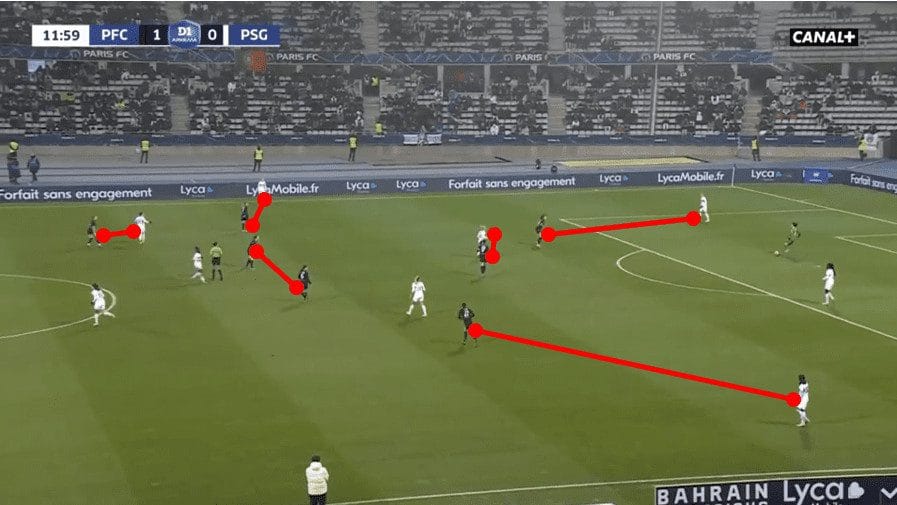
Above, you can see that PSG has two centre-backs on either side of the goalkeeper. You can see the two full-backs holding the width for the side. You then have the two pivots, Groenen and Albert. Notice how the main pivot is Groenen, and Albert plays more of a rotating pivot role. Then you, although not a flat line, do Bachmann on the right side, having swapped with Baltimore, who is playing more centrally here, then you have Martens on the left and Katoto just out of shot up front. All four of these players are between the defence-midfield lines of Paris.
Then let’s look at how Paris looks to deal with this. It’s not an aggressive press, but an opportunistic one with centre forward Ribadeira engaged by the right side centre back. Pivot Groenen engages Thiney. The fullbacks engage the two wingers. However, the weak side winger in this example Bussy, keeps tight to keep the shape compact centrally. However, if that ball was to be switched, there are several examples of her getting out wide to the ball and the left-side winger moving across. The two central midfielders for Paris had the most important job for the side: blocking central passing lanes for PSG. It is an essential job with PSG operating with a number ten in Bachmann but also with forwards capable of dropping in and being a problem for defenders.
Ok, so there’s the first problem for PSG, and the first solution they came up with was to drop one of the forwards into the midfield. However, Paris dealt with this in one of two ways. The first of these was to compress the midfield when these players were on the ball, with the two central midfielders and two forward players compressing the space and forcing the PSG player back. Method two, often used to prevent Katoto from dropping deep with the ball, was to send one of the defenders to track her into the midfield. Both these methods proved influential throughout the game.
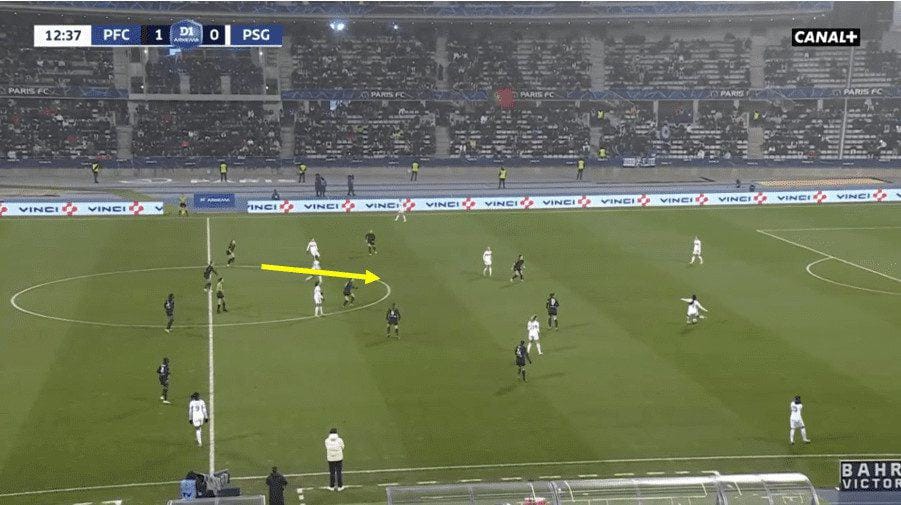
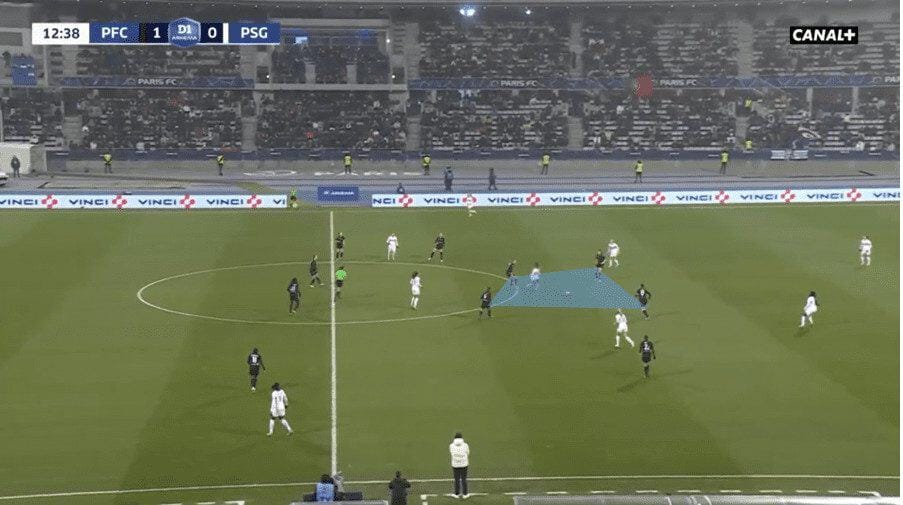
In this example, you can see Baltimore drop into the midfield to get onto the ball. Then, in the second picture below, you can see how the four Paris players close down the space and inevitably force her to go backwards and recycle possession.
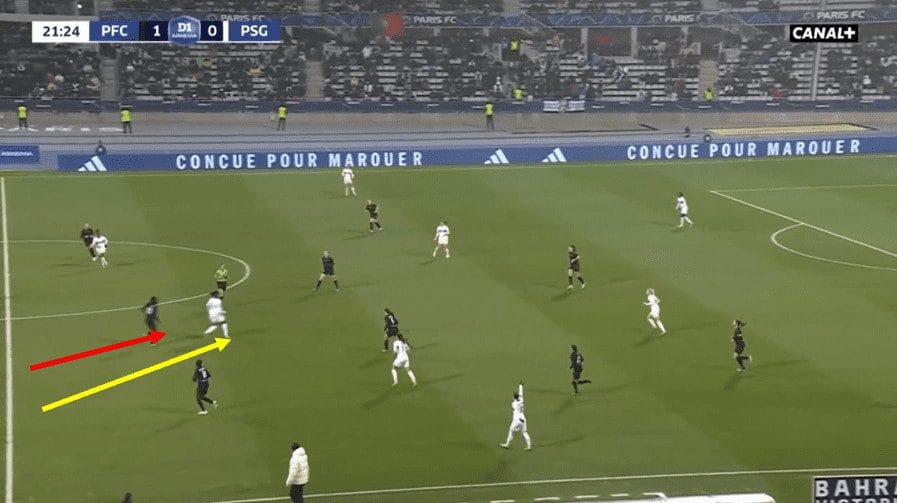
In this instance, central defender Sissoko tracks Katoto into the midfield, preventing her from turning.
Then came a sign of a way that they could potentially stretch the two central midfielders by putting one player on the outside shoulder of both midfielders, forcing them to work harder and cover more ground.
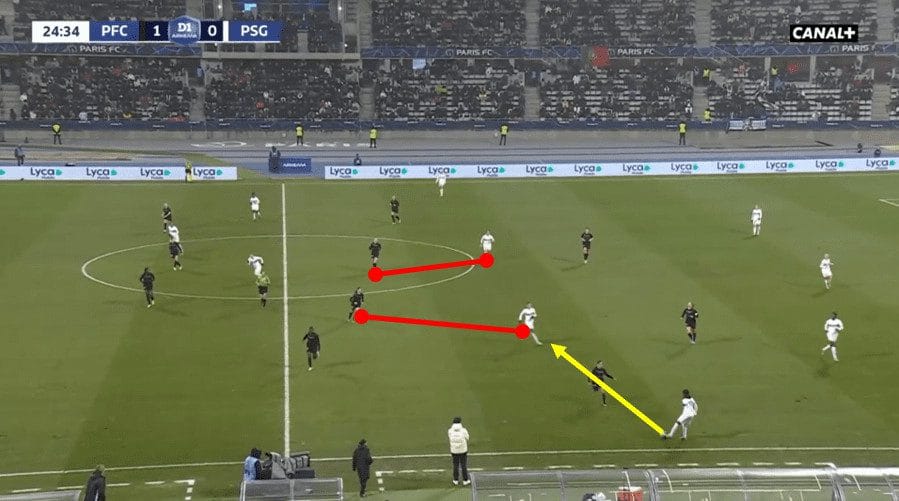
In this example, you have Groenen dropping into centre-back, which allows Martens to drop into midfield. The key, though, is the distance between the Martens and the other midfielder, Albert. Both stood wide of the midfielders, allowing them to attack the wide channel. In this example, Martens has the skill to drive past the defender and turn as she receives the ball facing her own goal and progress the ball quickly.
PSG changes and a more dynamic attack
At half-time, PSG boss Jocelyn Prêcheur decided to make three changes, replacing Katoto, Groenen and Martens with Grace Geyoro, Tabitha Chawinga and Clare Hunt. This made a significant impact on how PSG were able to attack in the second half and made them more dynamic as a side. Here, we will take a look at how they were able to do so.
The first thing to look at is how Geyoro was positioned in order to generate more space for herself to be able to create. Having taken on board what we learned in the first half. Her start position was considerably wider than Albert and the double pivots became a single pivot. Paris struggled to deal with this as it meant more people to deal with between the lines, and they were less able to block the passing lanes.
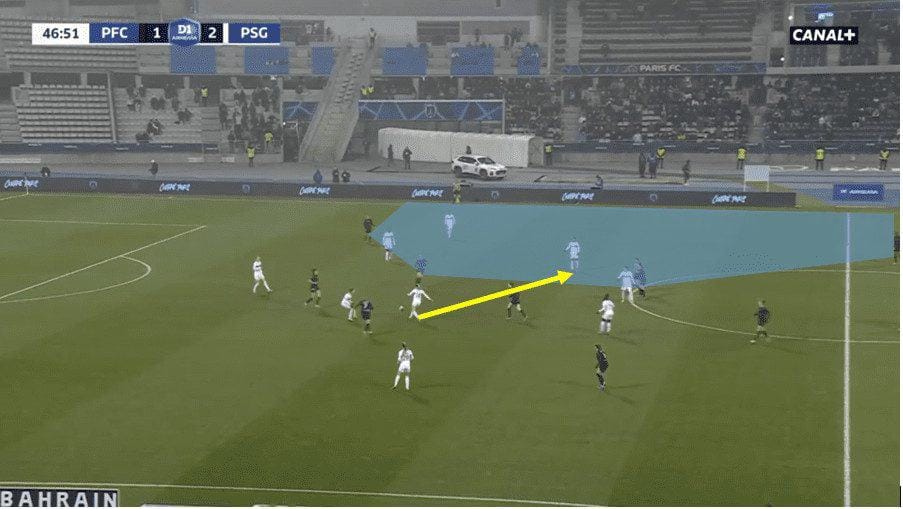
In the above example, Geyoro is significantly wider than Albert, who is on the ball. Equally, note the amount of space she is in because this is mainly coming off a loose ball where Paris’s shape is disorganised.
In addition to this ability, Geyoro added the ability to drive through a midfield on her own to the side, enabling them to break through the Paris shape more regularly and progress attacks in this manner instead.
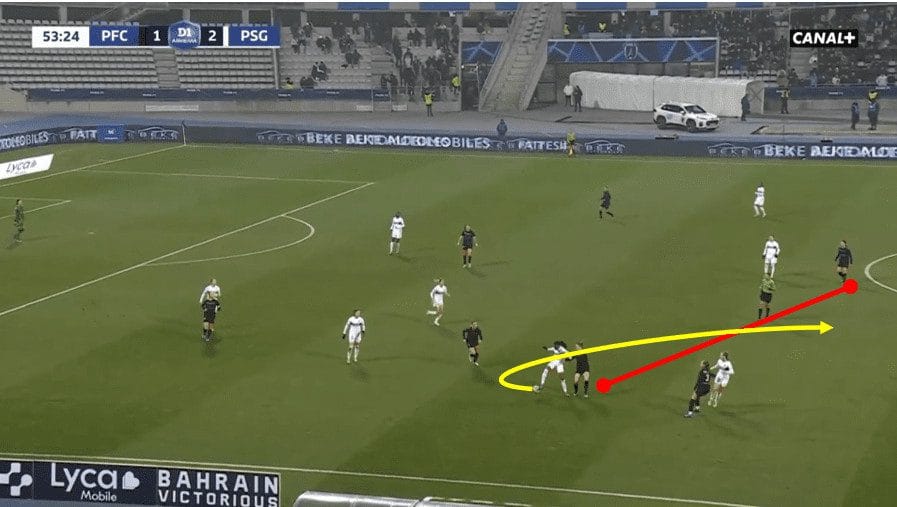
In this example, Geyoro is playing wider, drawing Le Mouel out wide with her. This, in turn, creates a disconnect and gap in the midfield area between Paris’ two central midfielders. So when Geyoro can beat Mouel one-on-one, she turns and then drives at the gap, gaining around 40m before passing the ball to a teammate.
A further way in which Geyoro added dynamism to the attack to help break down the Paris side was her ability to make vertical runs to get beyond the defensive line.
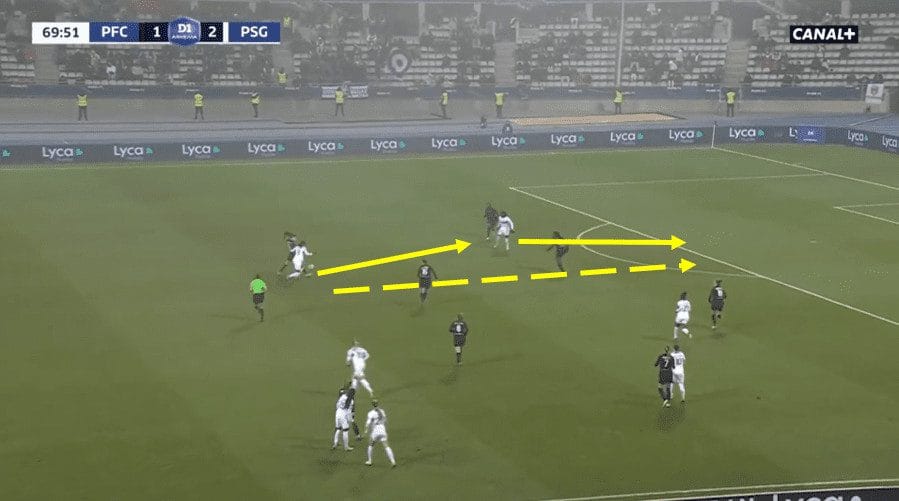
In this example, Geyoro gets the ball to Chawinga. Chawinga can then find Geyoro on the return ball as she continues to run between the two centre-backs, creating a further dilemma for the defensive line to deal with. In this instance, she is left one-on-one with the goalkeeper. However, she is unable to convert the chance.
The other change that made a significant difference in the game was the introduction of Chawinga off the bench. Chawinga’s greatest asset is her runs off the ball in behind the defence, and this is exactly what she tried to challenge as soon as she was introduced onto the field in an attempt to force Paris’s high defensive line back somewhat. In doing this, she was able to generate five shooting opportunities in the second half alone, but unfortunately, she could not convert on any of them.
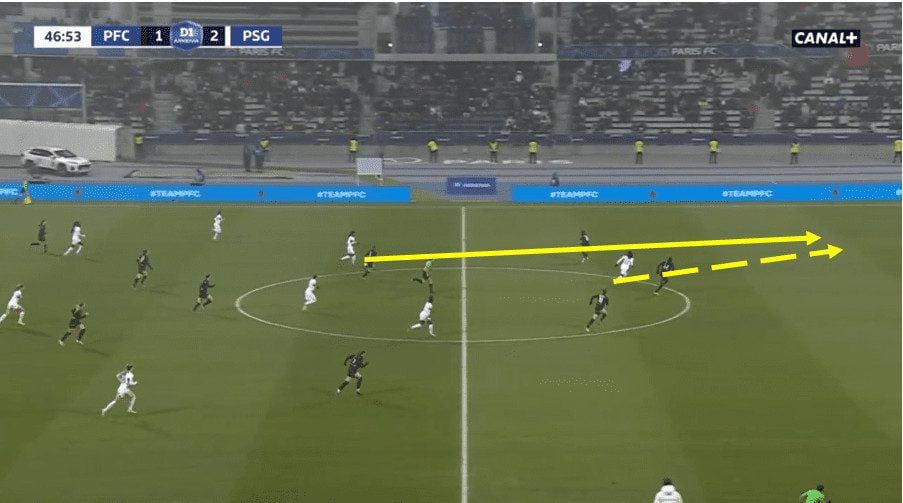
Goals decide Games
Ultimately, however, although the Paris press was able to stem the PSG possession in the first half, PSG were significantly more dynamic in possession during the second half. The game was decided by two counterattacks by PSG, where they could capitalise on the disorganised Paris shape and be clinical enough to finish off the chances as they came.
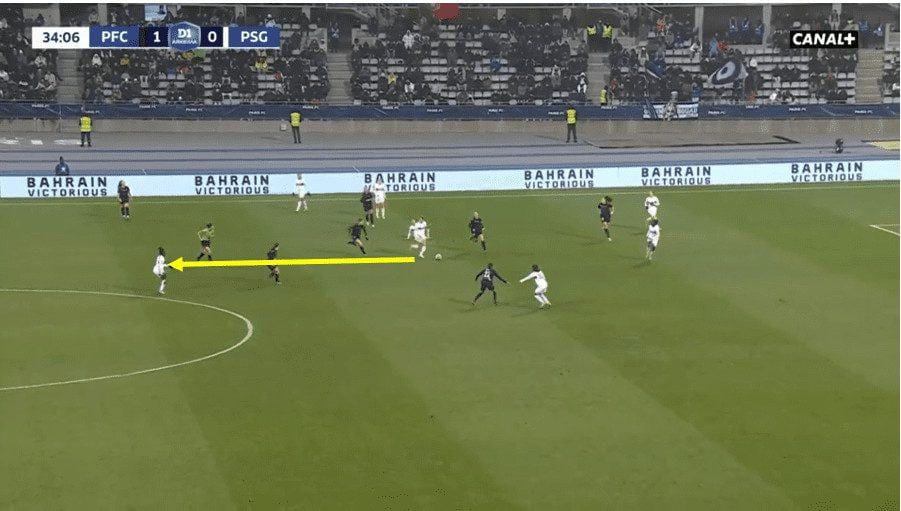
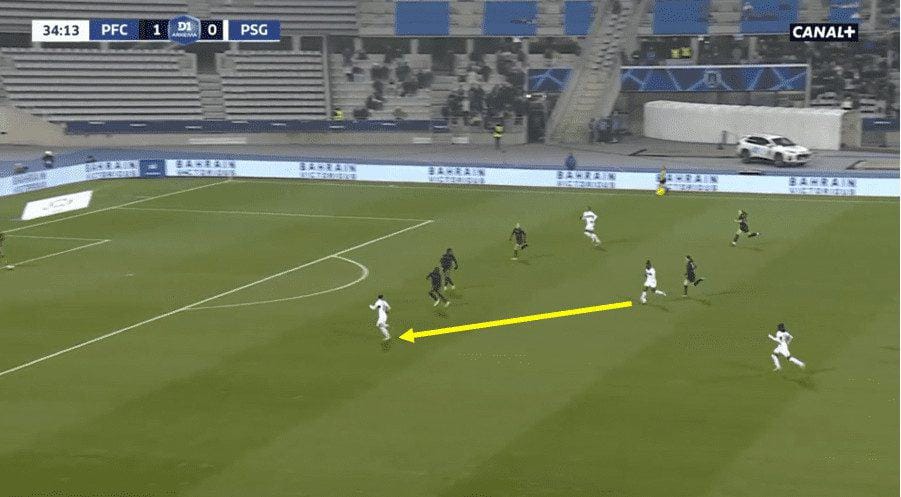
For the equalising goal by PSG, they were able to win the ball back from a throw-in. Paris’ shape is narrow and compact, and they look to regain possession and quickly counter press. However, they were unable to do so, and Groenen identified an excellent pass through a tight gap in the midfield for Baltimore to receive. Baltimore then drives forwards on the ball for 30m before playing the ball into Bachmann, who draws the foul for the penalty, which is duly converted by Baltimore.
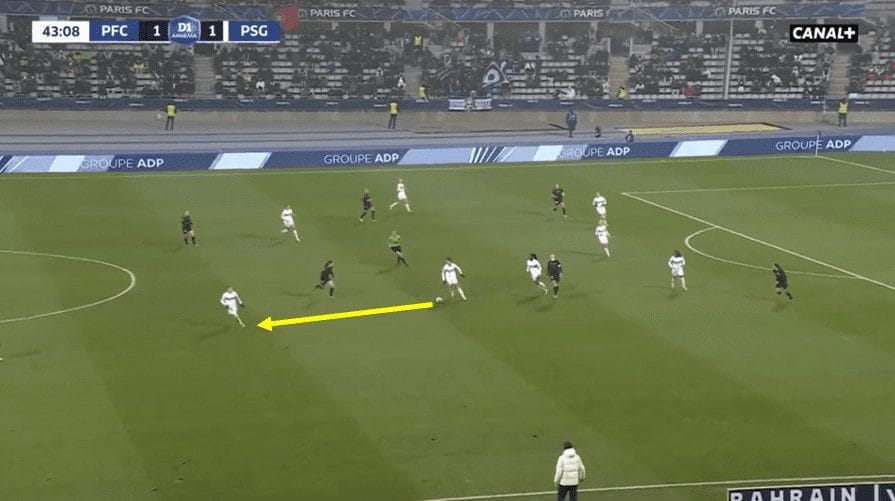
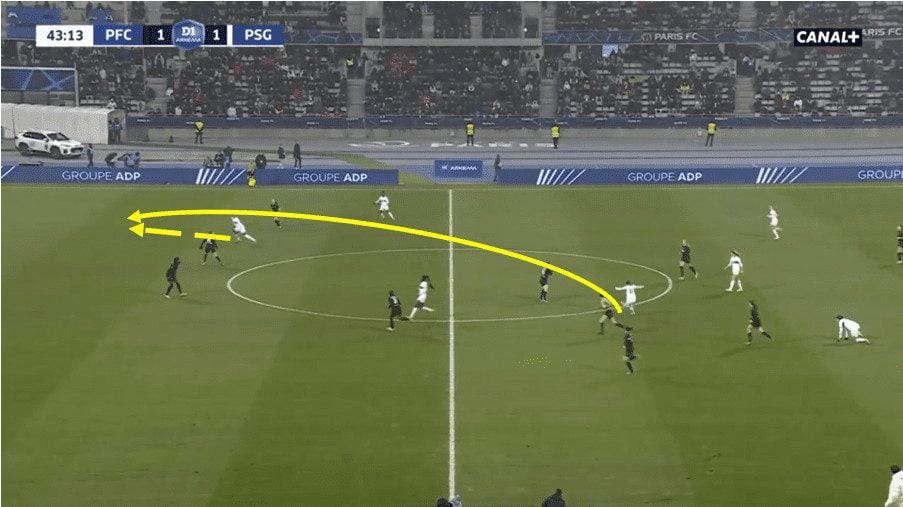
Then, eight minutes later, PSG won the ball back with Paris high up the field. The ball falls at Albert’s feet. She passes it onto Bachmann, drawing the foul from Paris midfielder Hunter. This creates a vast amount of space and time for Bachmann in the midfield, with four seconds lasting between Bachmann’s first receiving the ball and her eventually launching the ball over the top for Katoto to run onto. Katoto then has the quality to control the ball in her stride before finishing it off one-on-one with the goalkeeper to score the winner for PSG.
Conclusion
As you can see, this game had multiple small tactical battles throughout, with this tactical analysis only outlining one of the key battles throughout the game. The ability PSG had to adapt their game plan by using their bench ultimately proved to have a significant impact on the game, going from only three shots in the first half to eight shots in the second half and looking significantly more dynamic in doing so.
However, the game was ultimately not decided in these moments, but on two defence-attack transitions by PSG where Paris were caught out of their defensive shape and as such, PSG were clinical and punished them for it.






Comments